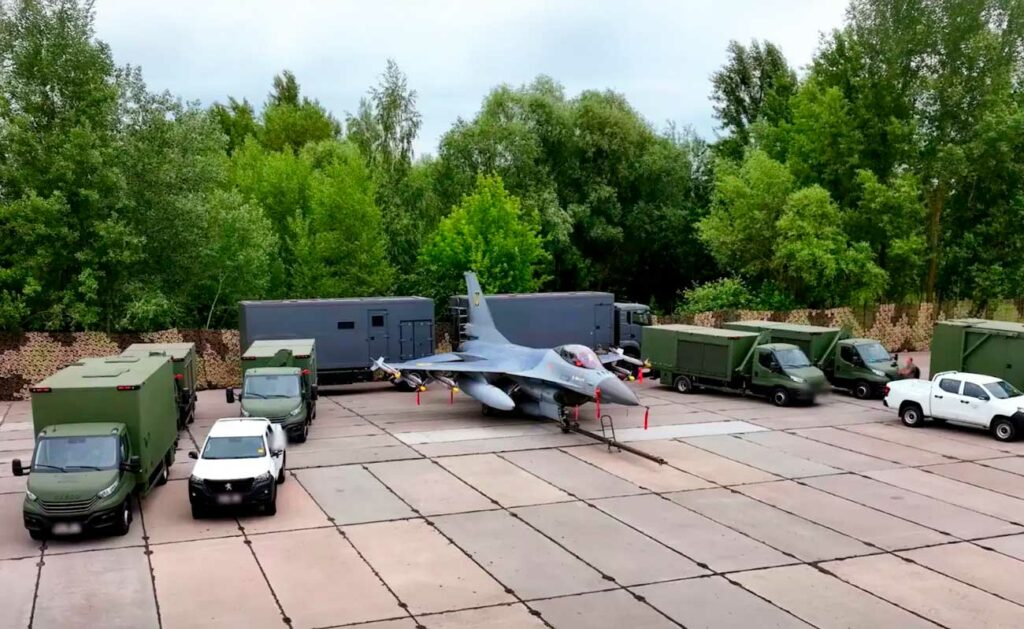
Mobile centers on trucks provide planning, maintenance, and armament for the F-16s, in accordance with the Agile Combat Employment doctrine.
Ukraine has implemented an innovative mobile strategy to protect its F-16 fighter jets from Russian strikes. Modules mounted on trucks provide mission planning, aircraft maintenance, and armament. These mobile centers avoid fixed bases that are vulnerable to Russian strikes, reducing the risk of destruction on the ground. Inspired by the Agile Combat Employment (ACE) doctrine, this approach is becoming a model for several NATO members. The vehicles, designed in cooperation between the Ukrainian army, local industry, and the Come Back Alive organization, offer flexibility, speed, and robustness.
Setting up the mobile system
Ukraine has received several truck-mounted mobile units that serve three purposes: mobile command post for mission planning, maintenance workshop, and weapons cell. One complex is dedicated to planning, pilot briefings, and personnel rest, while the other is used for weapons preparation and ammunition resupply. Initial funding came from support organizations such as Come Back Alive, in partnership with Ukrainian manufacturers.
These vehicles enable air support to be moved to different dispersed locations within a few hours, reducing the time spent in the same place and limiting the chances of being located or hit. The system allows an F-16 to be deployed from a non-military site in two to three hours under safe conditions.
Performance and operational data
At the end of July 2024, the first F-16s were delivered and entered operational service in August 2024, enabling the interception of several Russian cruise missiles and drones. In June 2025, four Ukrainian F-16s were shot down in air combat or by advanced Russian systems such as S-400s or R-37 air-to-air missiles.
The mobile system is used to maintain a reduced number of aircraft – between 10 and 20 in the second half of 2024, with a target of more than 20 in 2025. The complexes have reduced ground losses: aircraft rarely take off and land at the same airfield, spreading the risk.

The Agile Combat Employment doctrine in practice
The Agile Combat Employment doctrine, defined by the US Air Force in DN 1-21, is based on responsive deployment in threat areas, aiming to increase survivability while generating firepower. Ukraine has been applying this doctrine de facto since the beginning of the conflict, combining mobility, integrated air defense, and mobile passive bases.
The Ukrainian example is raising awareness within NATO: several exercises conducted in 2023-2024 (United Kingdom, United States, France) have incorporated dispersal and austere basing scenarios. Military officials now believe that operating from multiple non-traditional sites will become essential when facing adversaries with long-range missile capabilities.
Technical and logistical lessons learned
The model implemented by Ukraine requires robust vehicles, adequate ammunition stocks (APKWS, guided bombs), personnel trained in rapid rotation, and decentralized maintenance capabilities. The cost of F-16 support (training, spare parts, simulators) amounts to several hundred million dollars; for example, support includes a package of US$310 million for equipment, training, and upgrades.
Ukraine understood that its fixed infrastructure would be targeted and did not have time to build permanent facilities. The most rational solution was full mobile support, designed to be moved: complete planning and weapon modules. The intervention can be redeployed in less than 24 hours in the event of a strike alert.
Prospects for NATO and lessons for the future
This strategy now serves as a model for NATO countries facing peer-level threats such as Russia or China. Officials such as General Kevin Schneider (PACAF) assert that the era of heavily secured fixed bases is over, emphasizing the need for a resilient and dispersed air force.
Countries such as Finland, which are accustomed to road dispersal, have been adopting similar doctrines for years. However, several NATO countries must overcome cultural and budgetary obstacles to rethink the traditional use of centralized bases. The Ukrainian case shows that rapid structural change is possible when dictated by operational urgency.
Ukraine is thus demonstrating that it is possible to protect a fleet of modern fighter jets in a conflict zone against an adversary equipped with advanced missiles, without a fixed infrastructure. Mobile truck-mounted centers designed to plan, repair, and arm F-16s are a concrete application of Agile Combat Employment. Operational data—limited losses, rapid deployments, and effective missile defense—clearly validate this approach. This model is already inspiring doctrinal and logistical developments within NATO.
War Wings Daily is an independant magazine.